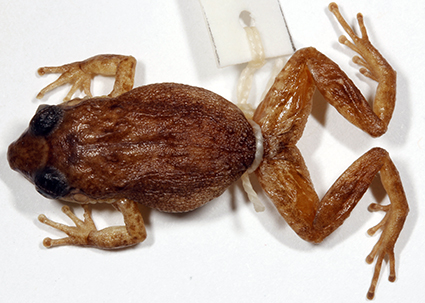Abstract
I describe a new species of frog, Eleutherodactylus montserratae sp. nov., from Montserrat, previously confused with E. johnstonei Barbour. It is native to that island and has been introduced, and established, on other Lesser Antillean islands west of 62 degrees west longitude including Anguilla, St. Martin/St. Maarten, St. Barthélemy, Saba, St. Eustatius, St. Christopher, and Nevis, as well as Bermuda. Previous chromosome and molecular studies have shown that populations from these islands are distinct from E. johnstonei, a species occurring east of 62 degrees west longitude in the Lesser Antilles, and elsewhere, but could not identify diagnostic morphological differences. Here, I show that the new species differs morphologically in being smaller (males and females) and having a proportionately larger tympanum, a wider head, and greater separation between the nostrils. Both species have been introduced within and outside of the Caribbean region and will likely expand their ranges in the future.
References
Auffenberg, W. (1958) A small fossil herpetofauna from Barbuda, Leeward Islands, with the description of a new species of Hyla. Quarterly Journal of the Florida Academy of Sciences, 21, 248–254. [https://www.jstor.org/stable/24315239]
Barbour, T. (1914) A contribution to the zoögeography of the West Indies, with especial reference to amphibians and reptiles. Memoirs of the Museum of Comparative Zoölogy, 44, 209–359, 201 pls. (includes 207 foldout tables). https://doi.org/10.5962/bhl.title.49187
Breuil, M. (2002) Histoire naturelle des amphibiens et reptiles terrestres de l’archipel Guadeloupéen. Guadeloupe, Saint Martin, Saint Barthelemy. Patrimoines Naturels, Paris, 54, 1–339.
GBIF (2022) Global Biodiversity Information Facility (GBIF) database. GBIF Secretariat. Available from: https://www.gbif.org/ (accessed 7 July 2022)
Hedges, S. B., Duellman, W. E. & Heinicke, M. P. (2008) New World direct-developing frogs (Anura: Terrarana): Molecular phylogeny, classification, biogeography, and conservation. Zootaxa, 1–182. https://doi.org/10.11646/zootaxa.1737.1.1.
Hedges, S.B., Powell, R., Henderson, R.W., Hanson, S. & Murphy, J.C. (2019) Definition of the Caribbean Islands biogeographic region, with checklist and recommendations for standardized common names of amphibians and reptiles. Caribbean Herpetology, 67, 1–53. https://doi.org/10.31611/ch.67
Henderson, R.W. & Powell, R. (2009) Natural history of West Indian amphibians and reptiles. University Press of Florida, Gainesville, Florida, 495 pp.
IUCN (2022) International Union for Conservation of Nature. Redlist of Threatened Species. International Union for the Conservation of Nature, Gland. Available from http://www.iucnredlist.org/ (accessed 10 January 2022)
Kaiser, H. (1992) The trade-mediated introduction of Eleutherodactylus martinicensis (Anura, Leptodactylidae) on St-Barthelemy, French Antilles, and its implications for Lesser Antillean biogeography. Journal of Herpetology, 26, 264–273. https://doi.org/10.2307/1564880.
Kaiser, H. (1997) Origins and introductions of the Caribbean frog, Eleutherodactylus johnstonei (Leptodactylidae): management and conservation concerns. Biodiversity and Conservation, 6, 1391–1407. https://doi.org/10.1023/A:1018341814510
Kaiser, H., Barrio-Amoros, C.L., Trujillo, J.D. & Lynch, J.D. (2002) Expansion of Eleutherodactylus johnstonei in northern South America: rapid dispersal through human interactions. Herpetological Review, 33, 290–293.
Kaiser, H., Green, D.M. & Schmid, M. (1994) Systematics and biogeography of eastern Caribbean Frogs (Leptodactylidae, Eleutherodactylus), with the description of a new species from Dominica. Canadian Journal of Zoology, 72, 2217–2237.
Leonhardt, F., Jimenez-Bolaño, J.D. & Ernst, R. (2019) Whistling invaders: status and distribution of Johnstone’s Whistling frog (Eleutherodactylus johnstonei Barbour, 1914), 25 years after its introduction to Colombia. NeoBiota, 45, 39–54. https://doi.org/10.3897/neobiota.45.33515
Lynch, J.D. (1966) The Status of the Tree Frog, Hyla barbudensis Auffenberg, from Barbuda, British West Indies. Copeia, 1966, 524–530. https://doi.org/10.2307/1441077
Moravec, J., Kodejs, K., Miller, V. & Velensky, P. (2020) Johnston’s whistling frog in Prague: report of populations of Eleutherodactylus johnstonei (Anura: Eleutherodactylidae) in the Czech Republic. Acta Societatis Zoologicae Bohemicae, 84, 39–46.
Schmid, M. & Steinlein, C. (2018) Chromosome banding in Amphibia. XXXVI. Multimorphic sex chromosomes and an enigmatic sex determination in Eleutherodactylus johnstonei (Anura, Eleutherodactylidae) Cytogenetic and Genome Research, 154, 86–98. https://doi.org/10.1159/000487660
Schmid, M., Steinlein, C., Bogart, J.P., Feichtinger, W., Leon, P., La Marca, E., Diaz, L.M., Sanz, A., Chen, S.H. & Hedges, S.B. (2010) The chromosomes of terraranan frogs. Insights into vertebrate cytogenetics. Cytogenetic and Genome Research, 130–131, 1–568. https://doi.org/10.1159/isbn.978-3-8055-9608-4
Schwartz, A. (1967) Frogs of the genus Eleutherodactylus in the Lesser Antilles. Studies on the Fauna of Curaçao and other Caribbean Islands, 24, 1–62.
Schwartz, A. & Henderson, R. (1991) Amphibians and reptiles of the West Indies: descriptions, distributions, and natural history. University of Florida Press, Gainesville, Florida, xvi + 720 pp.
Shu, G., Gong, Y., Xie, F., Wu, N. & Li, C. (2017) Effects of long-term preservation on amphibian body conditions: implications for historical morphological research. PeerJ, 5, e3805. https://doi.org/10.7717/peerj.3805
Yuan, M.L., Frederick, J.H., McGuire, J.A., Bell, R.C., Smith, S.R., Fenton, C., Cassius, J., Williams, R., Wang, I.J., Powell, R. & Hedges, S.B. (2022) Endemism, invasion, and overseas dispersal: the phylogeographic history of the Lesser Antillean frog, Eleutherodactylus johnstonei. Biological Invasions, 24, 2707–2722. https://doi.org/10.1007/s10530-022-02803-9


